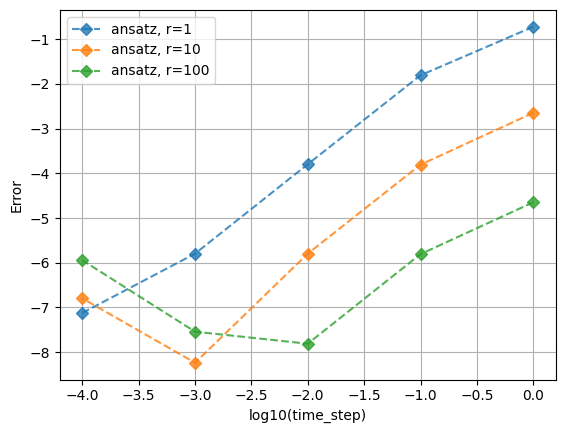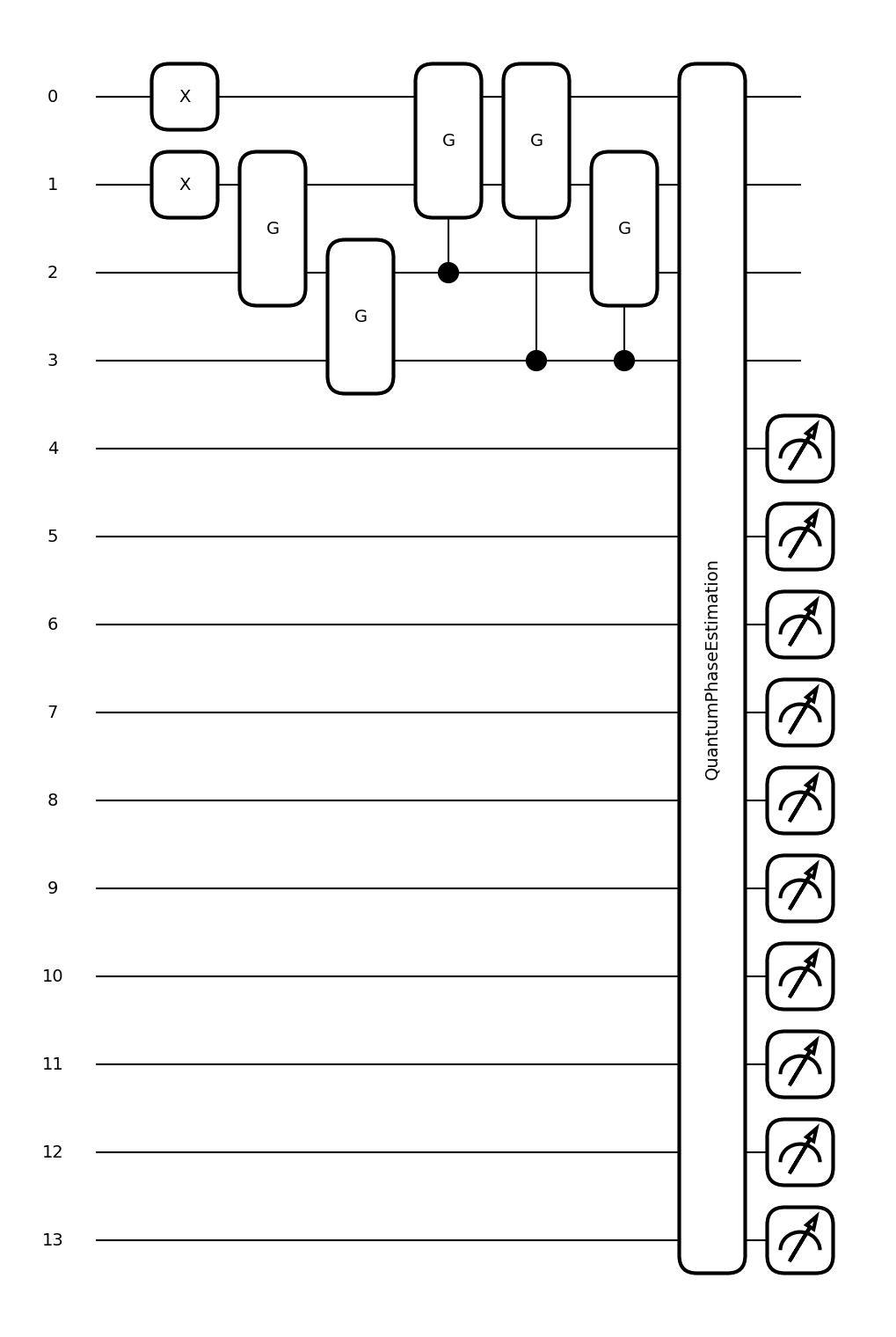11. pennylaneを用いたQPE計算#
この章では、pennylaneを使って、long-term algorithmである量子位相推定(QPE)の実装を行う。 まずは、ancilla qubitが1つの場合としてHadamard testを実装し、その後、QPEへと拡張する。
import numpy as o_np #pennylaneのnumpyと被らないように
import itertools
from itertools import combinations
import matplotlib.pyplot as plt
import pennylane as qml
from pennylane import numpy as np
from pennylane.templates import QuantumPhaseEstimation
Hamiltonianを再掲しておこう:
以下では、\(N_\mathrm{orb}=4, N_\mathrm{occ}=2, g = 0.33\)にとって考えることにする。 ansatz(状態作成)部分は\(N_\mathrm{orb}=4, N_\mathrm{occ}=2\)を、 角度パラメータは\(g=0.33\)のもとでの厳密解を与える値をそれぞれ仮定した実装である点を断っておく。
Norb = 4
Nocc = 2
gval = 0.33
Show code cell source
class PairingHamiltonian:
def __init__(self, Norb, Nocc, gval, delta_eps=1.0):
self.Norb = Norb
self.Nocc = Nocc
self.delta_eps = delta_eps
self.gval = gval
self.basis = self.make_basis()
self.epsilon = self.eval_epsilon()
self.Hmat = self.eval_Hmat()
def make_basis(self):
self.basis = []
for occ in combinations(range(self.Norb), self.Nocc):
self.basis.append(occ)
return self.basis
def eval_epsilon(self):
self.epsilon = [ 2 * i * self.delta_eps for i in range(self.Norb) ]
return self.epsilon
def eval_Hmat(self):
dim = len(self.basis)
self.Hmat = o_np.zeros((dim, dim))
for bra_idx, bra in enumerate(self.basis):
for ket_idx, ket in enumerate(self.basis):
# Hamming distance
diff = [ i for i in bra if i not in ket ]
same = [ i for i in bra if i in ket ]
# for SPE term
if bra_idx == ket_idx:
self.Hmat[bra_idx, ket_idx] += np.sum( [self.epsilon[i] for i in same])
self.Hmat[bra_idx, ket_idx] += - self.gval * len(same)
# for pairing term
if len(diff) == 1:
self.Hmat[bra_idx, ket_idx] = - self.gval
return self.Hmat
def tuple_to_bitstring(tup, Norb, rev=True):
bitint = 0
for i in tup:
bitint += 2**i
if rev:
bitstring = "|"+format(bitint, f'0{Norb}b')[::-1]+">"
else:
bitstring = "|"+format(bitint, f'0{Norb}b')+">"
return bitstring
def ij_tuple_to_AdagA_str(tuple_in):
i, j = tuple_in
return f"{i}^ {j}"
Hamil = PairingHamiltonian(Norb, Nocc, gval)
evals, evecs = o_np.linalg.eigh(Hamil.Hmat)
evals = o_np.linalg.eigvalsh(Hamil.Hmat)
Egs_exact = evals[0]
E_HF = Hamil.Hmat[0,0]
print("basis:", Hamil.basis)
print([tuple_to_bitstring(tup, Norb) for tup in Hamil.basis])
print("eps: ", Hamil.epsilon)
print("Hmat: ", Hamil.Hmat)
print("evals: ", evals)
print("Egs_exact: ", Egs_exact, " E_HF", E_HF)
print("gs evec", evecs[:,0])
# Qubit Hamiltonian
SPEs = Hamil.epsilon
obs = [ ]
coeffs = [ ]
# 1-Zp term
for i in range(Hamil.Norb):
op = qml.Identity(i) - qml.PauliZ(i)
obs += [ op ]
coeffs += [ 0.5 * (SPEs[i] - Hamil.gval) ]
# XX+YY term
for i in range(Hamil.Norb):
for j in range(Hamil.Norb):
if i == j:
continue
factor = - Hamil.gval / 4
XX = qml.PauliX(i) @ qml.PauliX(j); obs += [ XX ]; coeffs+= [ factor ]
YY = qml.PauliY(i) @ qml.PauliY(j); obs += [ YY ]; coeffs+= [ factor ]
H_qubit = qml.Hamiltonian(coeffs, obs)
print("H_qubit: ", H_qubit)
params_exact = 2 * np.array(
[-0.24052408031489098, -0.5198881673506184, -0.49481759937881004, -0.5924147175751697, -0.27420571516474473]
)
basis: [(0, 1), (0, 2), (0, 3), (1, 2), (1, 3), (2, 3)]
['|1100>', '|1010>', '|1001>', '|0110>', '|0101>', '|0011>']
eps: [0.0, 2.0, 4.0, 6.0]
Hmat: [[ 1.34 -0.33 -0.33 -0.33 -0.33 0. ]
[-0.33 3.34 -0.33 -0.33 0. -0.33]
[-0.33 -0.33 5.34 0. -0.33 -0.33]
[-0.33 -0.33 0. 5.34 -0.33 -0.33]
[-0.33 0. -0.33 -0.33 7.34 -0.33]
[ 0. -0.33 -0.33 -0.33 -0.33 9.34]]
evals: [1.18985184 3.29649666 5.34 5.34 7.42853393 9.44511758]
Egs_exact: 1.1898518351360725 E_HF 1.3399999999999999
gs evec [0.97121327 0.18194077 0.09817385 0.09817385 0.06360816 0.01789242]
H_qubit: -0.165 * (I(0) + -1 * Z(0)) + 0.835 * (I(1) + -1 * Z(1)) + 1.835 * (I(2) + -1 * Z(2)) + 2.835 * (I(3) + -1 * Z(3)) + -0.0825 * (X(0) @ X(1)) + -0.0825 * (Y(0) @ Y(1)) + -0.0825 * (X(0) @ X(2)) + -0.0825 * (Y(0) @ Y(2)) + -0.0825 * (X(0) @ X(3)) + -0.0825 * (Y(0) @ Y(3)) + -0.0825 * (X(1) @ X(0)) + -0.0825 * (Y(1) @ Y(0)) + -0.0825 * (X(1) @ X(2)) + -0.0825 * (Y(1) @ Y(2)) + -0.0825 * (X(1) @ X(3)) + -0.0825 * (Y(1) @ Y(3)) + -0.0825 * (X(2) @ X(0)) + -0.0825 * (Y(2) @ Y(0)) + -0.0825 * (X(2) @ X(1)) + -0.0825 * (Y(2) @ Y(1)) + -0.0825 * (X(2) @ X(3)) + -0.0825 * (Y(2) @ Y(3)) + -0.0825 * (X(3) @ X(0)) + -0.0825 * (Y(3) @ Y(0)) + -0.0825 * (X(3) @ X(1)) + -0.0825 * (Y(3) @ Y(1)) + -0.0825 * (X(3) @ X(2)) + -0.0825 * (Y(3) @ Y(2))
11.1. 時間発展演算子: \(U=\exp{(i\hat{H}t)}\)#
上のHamiltonianを少し整理して、1,2-body termで整理する:
また、以下ではPythonでの実装を想定して\(N\)量子ビット系を\(0\) ~ \(N-1\)でラベルすることにする。
すると、first-orderのTrotter-Suzuki分解(11.1)は以下のようにかける:
Trotter-Suzuki approximation
\(H=\sum^m_{i=1} h_i\)と非可換な項に分解できるとき、trotter-step \(r\)に対して、以下のように近似できる:
First-order:
Second-order:
また、一体項部分はPhase shift gateを用いて以下のようにまとめてかける:
pennylaneでは、Trotter分解を行うには、TrotterProductメソッドを用いて演算子とステップ数, 時間\(t\), 次数(order)を指定してやれば良い。
本当は、それぞれの項の交換性を考慮してGroupingするなどしてTrotter分解を行うべきだが、ここではTrotterProductに投げてしまうことにする。
11.2. Hadamard test#
n_ancilla = 1
dev = qml.device("default.qubit", wires=n_ancilla+Hamil.Norb)
@qml.qnode(dev)
def circuit_HadamardTest(H_qubit):
q_ancilla = Norb
# State preparation
if method_state == "HF":
qml.PauliX(0)
qml.PauliX(1)
if method_state == "ansatz":
qml.PauliX(0)
qml.PauliX(1)
qml.SingleExcitation(params_exact[0], wires=[1,2])
qml.SingleExcitation(params_exact[1], wires=[2,3])
qml.ctrl(qml.SingleExcitation, control=[2])(params_exact[2], wires=[0,1])
qml.ctrl(qml.SingleExcitation, control=[3])(params_exact[3], wires=[0,1])
qml.ctrl(qml.SingleExcitation, control=[3])(params_exact[4], wires=[1,2])
# Time Evolution
iHt = qml.TrotterProduct(H_qubit, n=trotter_step, time=time_step, order=1)
# Hadamard test
qml.Hadamard(wires=q_ancilla)
qml.ControlledQubitUnitary(iHt, control_wires=[q_ancilla], wires=range(0, Norb))
qml.Hadamard(wires=q_ancilla)
return qml.expval(qml.PauliZ(q_ancilla))
trotter_step = 10
time_step = 2.e-3
method_state = "ansatz"
res = circuit_HadamardTest(H_qubit).item()
p0, p1 = (1 + res) / 2, (1 - res) / 2
Et = np.arccos(res)
E = Et / time_step
print("initial state", method_state, "trotter_step %3d" % trotter_step,
"time_step %3.1e" % time_step, "E %12.9f" % E, "error %3.1e" % np.abs(E - Egs_exact))
initial state ansatz trotter_step 10 time_step 2.0e-03 E 1.189851898 error 6.3e-08
/Users/sym4p/my_python3_env_forQC/lib/python3.13/site-packages/pennylane/ops/op_math/controlled_ops.py:163: UserWarning: base operator already has wires; values specified through wires kwarg will be ignored.
warnings.warn(
厳密解から\(\exp(iEt)\)を計算するなどして検算してみよう。
# exp(iEt)
Uex = np.real(np.exp(1j * Egs_exact * time_step))
p0_exact = (1 + Uex)/2
p1_exact = (1 - Uex)/2
print("Uex", Uex, "p0_exact", p0_exact, "p1_exact", p1_exact)
print("Et", Egs_exact * time_step , "cos(Et)", np.cos(Egs_exact * time_step))
print("Egs_exact", Egs_exact, "E", E, "Diff.", E - Egs_exact)
Uex 0.9999971685065571 p0_exact 0.9999985842532786 p1_exact 1.4157467214670483e-06
Et 0.002379703670272145 cos(Et) 0.9999971685065571
Egs_exact 1.1898518351360725 E 1.189851897910462 Diff. 6.277438946433733e-08
初期状態やtrotter step, time stepなどを変えて試してみよう:
method_state = "ansatz"
results = []
for trotter_step in [1, 10, 100]:
for p_time_step in range(0, 5):
time_step = 10**(-p_time_step)
res = circuit_HadamardTest(H_qubit).item()
p0, p1 = (1 + res) / 2, (1 - res) / 2
Et = np.arccos(res)
E = Et / time_step
print("initial state %6s" % method_state,
"trotter_step %3d" % trotter_step,
"time_step %3.1e" % time_step, "E %12.9f" % E, "error %3.1e" % np.abs(E - Egs_exact))
results.append([method_state, trotter_step, np.log10(time_step), E, np.log10(np.abs(E - Egs_exact))])
initial state ansatz trotter_step 1 time_step 1.0e+00 E 1.379174376 error 1.9e-01
initial state ansatz trotter_step 1 time_step 1.0e-01 E 1.205431296 error 1.6e-02
initial state ansatz trotter_step 1 time_step 1.0e-02 E 1.190011501 error 1.6e-04
initial state ansatz trotter_step 1 time_step 1.0e-03 E 1.189853433 error 1.6e-06
initial state ansatz trotter_step 1 time_step 1.0e-04 E 1.189851760 error 7.5e-08
initial state ansatz trotter_step 10 time_step 1.0e+00 E 1.192102064 error 2.3e-03
initial state ansatz trotter_step 10 time_step 1.0e-01 E 1.190007796 error 1.6e-04
initial state ansatz trotter_step 10 time_step 1.0e-02 E 1.189853432 error 1.6e-06
initial state ansatz trotter_step 10 time_step 1.0e-03 E 1.189851841 error 5.8e-09
initial state ansatz trotter_step 10 time_step 1.0e-04 E 1.189851676 error 1.6e-07
initial state ansatz trotter_step 100 time_step 1.0e+00 E 1.189874324 error 2.2e-05
initial state ansatz trotter_step 100 time_step 1.0e-01 E 1.189853395 error 1.6e-06
initial state ansatz trotter_step 100 time_step 1.0e-02 E 1.189851851 error 1.5e-08
initial state ansatz trotter_step 100 time_step 1.0e-03 E 1.189851806 error 2.9e-08
initial state ansatz trotter_step 100 time_step 1.0e-04 E 1.189850696 error 1.1e-06
fig = plt.figure()
ax = fig.add_subplot(111)
results = o_np.array(results)
for method_state in ["ansatz"]:
tm = "o" if method_state == "HF" else "D"
for trotter_step in [1, 10, 100]:
mask = (results[:,0] == method_state) & (results[:,1] == str(trotter_step) )
x = list(map(float, results[mask, 2]))
y = list(map(float, results[mask, 4]))
ax.plot(x, y, marker=tm, ls="dashed", label=f"{method_state}, r={trotter_step}", alpha=0.8)
#ax.set_xscale("log")
#ax.set_yscale("log")
ax.set_xlabel("log10(time_step)")
ax.set_ylabel("Error")
ax.legend()
ax.grid()
plt.show()

11.3. QPE#
pennylaneのIntro to Quantum Phase Estimationも参考にしてみよう。
def float_from_binary(binary):
return sum([int(x) * 2**(-i-1) for i, x in enumerate(binary[2:])])
n_ancilla = 10
dev = qml.device("default.qubit", wires=n_ancilla+Hamil.Norb)
@qml.qnode(dev)
def circuit_QPE(H_qubit, method_state="ansatz"):
ancilla_wires = list(range(Norb, Norb+n_ancilla))
# State preparation
if method_state == "HF" or method_state == "ansatz":
qml.PauliX(0)
qml.PauliX(1)
elif method_state == "Hadamard":
for q in range(Norb):
qml.Hadamard(wires=q)
else:
raise ValueError("method_state "+ method_state +" not implemented")
if method_state == "ansatz":
qml.SingleExcitation(params_exact[0], wires=[1,2])
qml.SingleExcitation(params_exact[1], wires=[2,3])
qml.ctrl(qml.SingleExcitation, control=[2])(params_exact[2], wires=[0,1])
qml.ctrl(qml.SingleExcitation, control=[3])(params_exact[3], wires=[0,1])
qml.ctrl(qml.SingleExcitation, control=[3])(params_exact[4], wires=[1,2])
# Time Evolution
iHt = qml.TrotterProduct(H_qubit, n=trotter_step, time=time_step)
Op = iHt
# Quantum Phase Estimation
QuantumPhaseEstimation(
Op,
estimation_wires=ancilla_wires,
)
return qml.probs(wires=ancilla_wires)
fig, ax = qml.draw_mpl(circuit_QPE)(H_qubit)

method_state = "ansatz"
trotter_step = 20
time_step = 1.e-1
res = circuit_QPE(H_qubit, method_state)
ancilla_wires = list(range(Norb, Norb+n_ancilla))
idx = np.argmax(res)
E_estimated = idx / 2**n_ancilla * 2 * o_np.pi / time_step
print(f"E_estimated: {E_estimated:.8f} Egs_exact: {Egs_exact:.8f} diff. {E_estimated - Egs_exact:.2e}")
E_estimated: 1.16582540 Egs_exact: 1.18985184 diff. -2.40e-02
QPEの場合は、ターゲット量子ビットに作成する状態が厳密解でなくとも、(~ \(/N_q\))の精度で位相(エネルギー)を推定できる。
method_state = "HF"
res = circuit_QPE(H_qubit, method_state)
idx = np.argmax(res)
E_estimated = idx / 2**n_ancilla * 2 * o_np.pi / time_step
print(f"E_estimated: {E_estimated:.8f} Egs_exact: {Egs_exact:.8f} diff. {E_estimated - Egs_exact:.2e}")
E_estimated: 1.16582540 Egs_exact: 1.18985184 diff. -2.40e-02
